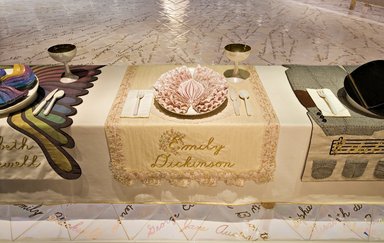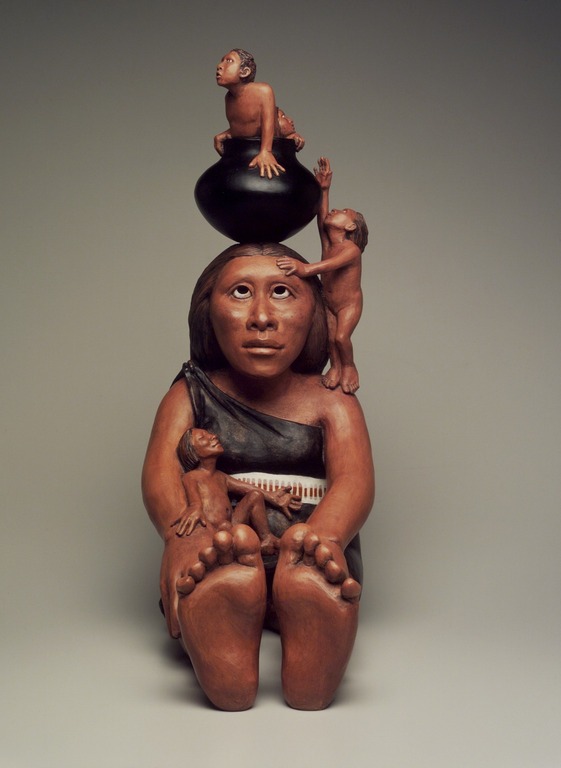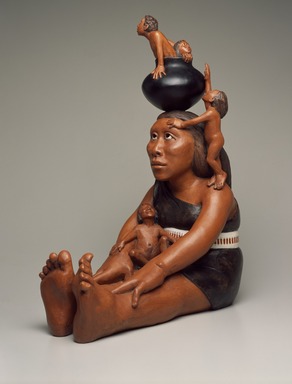After visiting the Brooklyn Museum, I was intrigued by the female artists whose works were displayed in the exhibitions. For centuries, female artists have had to fight patriarchal mindsets that they weren't good enough artists and it was interesting to see how far we've come from these time periods. Although, the fight for equality remains today it has certainly developed over time. A few of the artists that caught my attention were Kara Walker, Judy Chicago, Roxanne Swentzell, Georgia O'Keeffe, Sylvia Plimack Mangold. Each woman represented a different time period in American Art, with the exception of Roxanne Swentzell.
 |
| Kara Walker, headshot |
Kara Walker was born in 1969 and is best remembered as one of the first African American contemporary artists who explored all aspects of sociology and made bold statements with them. She explored and crossed boundaries within race, gender, sexuality, identity, and violence in her own work. She is widely known for her life size black cut-paper silhouettes that depict all of the social justice movements during her time. One of my favorite pieces, which so happened to be displayed at the Brooklyn Museum was "Keys to the Coop." Kara along with museum collectors have described this piece as, " a young African American girl in bold silhouette, holding the decapitated head of a chicken in one hand, while in the other she nonchalantly twirls a large key. Walker portrays a self-empowered anti-heroine who possesses the key to her own salvation, in stark black-and-white." It dates back to 1997 and is hung at the exhibition of "Contemporary Art" at the museum.
 |
| Judy Chicago, "The Dinner Party" |
 |
| Cindy Dickinson plate at "The Dinner Party" |
 |
| Headshot of Roxanne Swentzell. |
Roxanne Swentzell was a famous Native American clay and bronze sculptor and contemporary pueblo artist. Each of her masterpieces depicted a wide range of emotions people of her "pueblo," specifically women. She focused on female portraits, not necessarily drawing them in specific detail but more in an interpretive manner to balance the power between both sexes. Due to a speech impediment, she used her talent to effectively communicate with people. This remains one of her key elements when she is sculpting human life or emotions. One piece that the Brooklyn museum hosts is, "Making Babies for Indian Market." It depicts an everyday woman in Santa Fe Indian Market who is trying to sell the traditional hand made pots in order to help maintain her ever growing family, but also has a humorous twist to it as the children are interrupting her business. The figure's face resembles the artist herself, Roxanne Swentzell. This entire piece demonstrates an impressive performance that was managed with great skill; it merges two worlds (the traditional and the modern). Her work is displayed in "The Arts of the Americas" at the Brooklyn Museum.
Georgia O' Keefe who lived to be almost one hundred years old was an American artist who is often referred to as the "Mother of American Modernism. She is best remembered for her flower paintings, New York and New Mexico's landscapes. She was often quoted regarding her work in an imaginary tone, "I have things in my head that are not like what anyone taught me — shapes and ideas so near to me,so natural to my way of being and thinking.” Often her flower paintings were criticized for depicted women vaginal areas, but she felt as though there was nothing wrong with that. Being one the early feminist who influenced many talented women, she decided to remain a controversial artist during her time. However, even when she painted scenic view as New York skyscrapers they still carried sensual meaning with them. The one piece I noted at the Brooklyn Museum was none other than the, "Brooklyn Bridge" which is hosted at the American Identities: A New Look, Orientation Gallery on the fifth floor. Some believe that this was painted in a Gothic-style and it was her farewell to the city before relocating to New Mexico. With modernism she embraced urban life and the technological advancement occurring in the United States. She was a woman of many talents.
 |
| O' Keefe's "Brooklyn Bridge" |

The final artist I saw at the Brooklyn Museum was Sylvia Plimack Mangold, an American artist born in 1938. She is often remembered for depicting interior design (what a house usually looks like on the inside) and landscapes. She is a painter, pastelist, and printmaker. The piece I questioned as I roamed the Brooklyn Museum was her, "Floor with Laundry No. 3" which dates back to 1971. It was labeled as a contemporary art piece in American Identities: A New Look, Everyday Life/A Nation Divided. She managed to depict what a domestic household would look like on a busy morning. Drawing on an exaggerated scale, she drew the clothing pieces quite small so the viewer can see the extremeness of the painting. This was your everyday American household view, the parents were rushing to their jobs or to make breakfast and the kids were off to school. It was the unsaid portion of the "American Dream."
 |
| "Floor with Laundry No. 3" |
Overall, the trip to the Brooklyn Museum allowed me to appreciate art on a much depper level. As Agnes Martin once said, "Art is the concrete representation of our most subtle feelings."
Bibliography:
- Kara Walker (American, born 1969). Keys to the Coop, 1997. Linocut on paper, 46 1/4 x 60 1/2 in. (117.5 x 153.7 cm). Brooklyn Museum, Robert A. Levinson Fund, 1997.152. © Kara Walker
- Judy Chicago (American, born 1939). The Dinner Party, 1974-1979. Ceramic, porcelain, textile; triangular table, 576 x 576 in. (1463 x 1463 cm). Brooklyn Museum, Gift of The Elizabeth A. Sackler Foundation, 2002.10. © Judy Chicago
- Roxanne Swentzell (Kah'p'oo Owinge (Santa Clara Pueblo), Native American, born 1962). Making Babies for Indian Market, 2004. Clay, pigment, 23 1/2 x 8 1/2 x 17 in. (59.7 x 21.6 x 43.2 cm). Brooklyn Museum, Gift in memory of Helen Thomas Kennedy, 2004.80. © Roxanne Swentzell
- Georgia O'Keeffe (American, 1887-1986). Brooklyn Bridge, 1949. Oil on masonite, 47 15/16 x 35 7/8 in. (121.8 x 91 cm). Brooklyn Museum, Bequest of Mary Childs Draper, 77.11. © artist or artist's estate
- Sylvia Plimack Mangold (American, born 1938). Floor with Laundry No. 3, 1971. Acrylic and pencil on canvas, 44 x 56 in. (111.8 x 142.2cm). Brooklyn Museum, Gift of Ivan and Sharon Koota in memory of Miriam Miller, 1993.213. © Sylvia Plimack Mangold





No comments:
Post a Comment